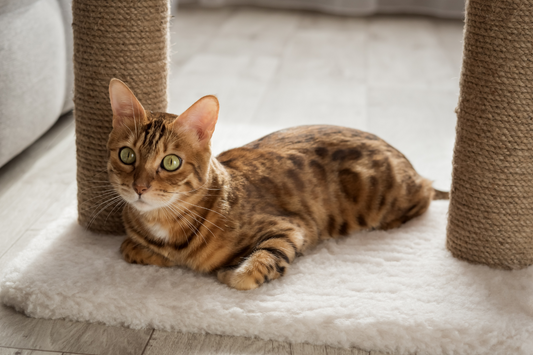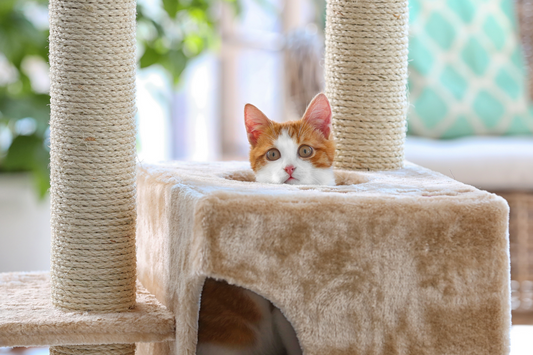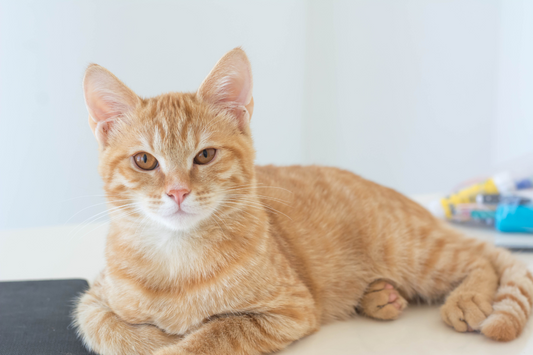
If your favorite armchair has turned into a feline claw zone, you’re not alone. Scratching is a perfectly normal behavior in cats, but that doesn’t mean your furniture has to suffer.
The good news is, with the right training techniques and some patience, you can teach your cat to scratch where you want them to.
In this guide, we’ll explain why cats scratch, how to choose the right scratcher, where to place it, and most importantly, how to train your cat to use it consistently and confidently.
Why Do Cats Scratch? Understanding the Behavior
Scratching isn’t just a habit—it’s a vital part of a cat’s daily routine. It helps them shed the outer layers of their claws, stretch their bodies, mark their territory using scent glands in their paws, and relieve stress or anxiety. It's an instinctive behavior rooted in both physical and emotional well-being.
That’s why punishing your cat for scratching is counterproductive. The key is to redirect this natural behavior toward appropriate scratching surfaces rather than trying to suppress it entirely.
Choosing the Right Scratcher for Your Cat
Cats can be surprisingly particular about where and how they scratch. Some prefer rough materials, while others like softer textures. The most common scratcher types include vertical posts, horizontal pads, and inclined ramps.
Sisal rope or sisal fabric is often preferred because it provides a satisfying texture. Cardboard is another popular choice—it’s affordable and surprisingly appealing to many cats.
Size matters, too. A vertical scratcher should be tall enough for your cat to fully stretch out, especially for larger or more active cats. On the other hand, some cats may prefer a flat scratcher they can dig into from the floor.
If your cat isn't showing interest in one type of scratcher, don’t give up. Sometimes offering a different texture, shape, or size can make all the difference.
Where to Place a Cat Scratcher for Maximum Use
Even the best scratcher won't help if placed in the wrong spot. One of the biggest mistakes cat owners make is tucking the scratcher away in a quiet corner or spare room, far from where the cat spends most of their time.
Try placing the scratcher near the furniture your cat is already scratching. This makes it easy for your cat to transition to the new surface. Many cats also like to scratch and stretch after a nap, so positioning a scratcher near their favorite sleeping area can be effective.
You might also find that your cat responds better to having multiple scratchers in different parts of the house, especially if you have more than one cat.
And don’t forget—stability is key. A scratcher that wobbles or tips over can frighten your cat and make them avoid it entirely.
Training Your Cat to Use a Scratcher
Training your cat to use a scratcher is all about positive reinforcement. Start by making the scratcher attractive to your cat. You can sprinkle a bit of catnip on it, use a pheromone spray, or simply place it in an area where your cat already likes to hang out. Encourage interaction with the scratcher by playing nearby with a feather wand or a toy mouse.
If your cat shows interest—even if they just sniff or touch it—offer a small treat and some verbal praise. Positive associations will build trust and help the behavior stick.
You can also gently guide your cat’s paws along the scratcher to show them how to use it. However, don’t force it. Cats are independent animals and respond best when they feel in control. Avoid scolding or pushing—this may lead to fear or resistance.
Some cat owners find success using clicker training, rewarding the cat every time it uses the scratcher correctly. This method takes consistency but can yield long-term results, especially for kittens or more trainable adult cats.
Mistakes to Avoid During the Process
A few common mistakes can delay your progress or make training harder than it needs to be. Avoid punishing your cat when they scratch furniture—this only leads to confusion and fear, and doesn’t teach them an alternative behavior.
Also, don’t use strong-smelling sprays or deterrents directly on the scratcher. While they may work to keep cats away from furniture, the same scent on a scratcher can make it completely unappealing.
Lastly, be patient. If your cat doesn’t immediately take to the new scratcher, it doesn’t mean they won’t ever use it. Some cats simply need more time to adjust—especially if they’re older or were previously discouraged from scratching at all.
How Long Does It Take to Train a Cat to Use a Scratcher?
There’s no one-size-fits-all timeline when it comes to cat training. Some cats take to a new scratcher in just a few days, while others may need a few weeks of consistent encouragement.
You'll know you're on the right track when your cat begins using the scratcher independently and stops scratching your furniture. Other signs of success include your cat lounging near the scratcher, rubbing their cheeks on it, or stretching out on it.
Consistency is the secret ingredient. Keep up the positive reinforcement and reward your cat every time they get it right.
Final Thoughts: Encourage Healthy Scratching for a Happier Cat (and a Scratch-Free Home)
Training your cat to use a scratcher is more than just saving your sofa—it’s about providing a healthy outlet for your cat’s natural instincts. With the right combination of placement, materials, and encouragement, your cat can learn to scratch smartly and confidently.
Whether you're a new pet parent, introducing a scratcher to a rescued cat, or simply trying to protect your home décor, patience and positivity will go a long way.
Remember, every cat is unique. By observing their preferences and responding with gentle guidance, you’ll be well on your way to a happier cat and a happier home.











